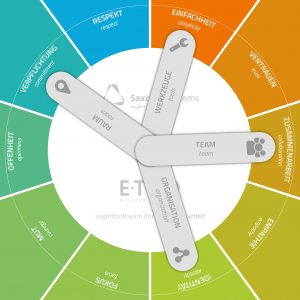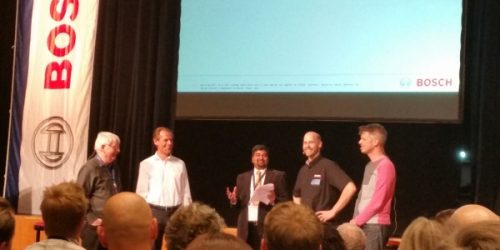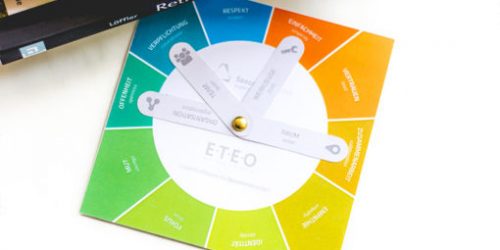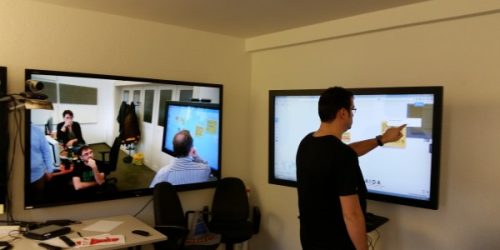How we extend the Five Core Scrum Values for Distributed Agile Teams
During our work in distributed teams, we identified many aspects which might have an effect on successful collaboration such as the distributed project room, the processes and roles, the tools and the team skills. However, we also recognized the five core scrum values which in fact give orientation and foundation for the successful implementation of any self-organized work. Common values within a team and a common understanding help to build culture and collaboration. Therefore, we decided to revise and to extend the 5 core values of scrum to 10 values of distributed teams. Discussing these values helps us, to continuously improve our work.

In the past, distributed scrum is controversially discussed. Although, we also prefer co-located teams, some of our scrum teams began to successfully work distributed and we decided to reflect their work and to support further teams with our experience. Our concept ETEO (“Ein Team Ein Office”), which means one team one office, tries to provide best-practices, solutions, tools and methods to connect distributed teams as good as possible like co-located teams. ETEO has four main pillars: 1) a distributed project room, 2) roles and processes respectively organization, 3) adequate collaboration tools such as the eteoBoard, and 4) the team which is engaged in distributed work. We started to reflect these pillars with the core scrum values and identified new values for distributed teams.
Scrum Values and Values for Distributed Teams
| Scrum Core Values | Value for Distributed Teams |
| Focus
Courage Openness Commitment Respect |
Identity
Empathy Collaboration Trust Simplicity |
Focus
Focus is the driving factor to reduce overhead and to work on the most important item with the most value. Every distraction should be avoided to concentrate on what is really necessary in the moment to deliver valuable items sooner. However, distributed work is a great danger to focus. Team members might be dispersed all over the world, working and living in other contexts. Virtual collaboration often implies technical problems which are time-consuming. Checking if a team mate is currently working or ready for a call also may lead to lose focus. Writing mails or long documentation prevent efficient collaboration.
Therefore, we suggest a distributed project room where all team members are permanently connected with a video conference system. Everyone sees each other and one can instantly communicate. The roles need to be more aware of focus distraction. For example, during virtual meetings it needs to be checked regularly if all persons are in touch with each other. This might be a task for the Scrum Master. Clear time slots can reduce exhaustion. The used tools need to support focus instead of raising distraction. Finally, the team needs to acquire principles to work in a focused way even in distribution. These are just some examples, if we consider how distributed work has an impact on focus and how we can deal with it.
Courage
Courage is important to be able to try out new things and to be ready for great challenges. However, in distributed teams courage is even more important to overcome the communication gap. Asking questions, mention conflicts and defend the needs of a distributed team in its organization requires much courage from each team member. Further, the organization needs to trust the team and that it does its best to handle virtual collaboration. Therefore, we also say yes to courage as an important value in distribution which needs to be cultivated. The project room and the tools can support courage because they can lower the inhibition threshold. Also the involved roles need to take care about courage.
Openness
Openness allows us to express ourselves. This implies our feeling, our working state and our ideas and requires an appropriate environment and culture. One main challenge in distributed teams is to provide trust to allow openness. The project room and the tools can support openness because they can provide transparency over the project state and the feelings of the team members. However, the roles and the team itself are also responsible to provide the situation for open thinking and acting. Openness is also a requirement for trying new things which is essential when coping with the challenges of distributed work.
Commitment
The scrum team has control over its working process as well as what it wants to achieve. Therefore, it is rather committing to own destiny and it is more likely that it will achieve this goal. Distributed teams may suffer from being in touch with all team mates and therefore, the commitment to each other and to the sprint goal may be less strong. However, a digital scrum board which is always visible to all team members within the project room supports the feeling to be one team and provides always access to my own commitment as well as to the commitment of the whole team. Overall, commitment needs also to be addressed and preserved in distributed teams.
Respect
Every team member has strengths and weaknesses, which need to be respected to be able to learn and grow. In distributed teams respect gets a further dimension. We also need to respect other partial teams working at other locations. Regarding the project room, this implies that cameras and tables are aligned that way that nobody can hide behind a monitor and observe the others. Also the camera should be placed in eye height. Bird’s eye view may feel others inferior or superior which is a bad idea when requiring a respectful environment. Further, every team should have the same equipment, tools and access to all infrastructures – an obvious requirement but not always a matter of course.
Identity
While identity naturally grows in co-located teams (sharing one room, meeting in everyday life, coffee breaks), it can be difficult in distributed teams. Since collaboration space is virtual and conversations tend to be limited and related to topics of work, only some team members seem to be more in touch than others. Lack of identity can lead to less commitment. Therefore, we added identity as the first important value for distributed teams. Some ideas to improve identity are team building workshops and work phases at one location at the beginning of a project. Also regular meetings at one location can help. Finally, also common artefacts (and the creation of those) like a team charta, a team name or a team logo can help to build identity.
Empathy
The most information in human communication is transferred in a non-verbal manner. We recognize unconsciously the feelings, the needs and the conflicts more likely in face-to-face meetings. However, in distributed teams the channel of communication is reduced, which may lead to latent conflicts or misunderstanding. Therefore, we suggest that the team uses the video conference system as much as possible. High definition and a permanent view of the other team allows us to see early if something happens on the other side. Furthermore, each team mate may actively ask how others feel or be more sensible, for example, during the Daily meeting. Everyone needs to ensure that everyone stays in touch. Not seeing a person over many hours can lead to exclusion from discussion and decisions which can cause problems. On the one hand, we suggest that team mates try to think of their colleagues, how they feel and if they need something to be happy. On the other hand, of course, everyone needs also to “act as a grown up” and be more active in expressing her or his needs directly.
Collaboration
We added collaboration as value because we would like to emphasize the fact that we understand a distributed team as a real team that works together without compromise. We want to integrate cross-functional team mates, to share the knowledge and make use of the intelligence of all team members. Collaboration requires a lot of communication and therefore, an important aspect in virtual teams. Fostering this value means to reflect the communication practices within the team and to optimize them as needed. Collaboration is mainly supported by the project room, appropriate tools, and, last but not least, the communication skills of each team member.
Trust
Trust is essential for good collaboration. It requires team members to believe that their colleagues have the knowledge, competence, and integrity to complete their assigned tasks. Trust builds the environment in which team members admit failures and help each other. Mistrust is real danger for teams because it raises conflicts, isolation and reduces productivity. Distributed teams suffer from the absence of face-to-face communication which reduces opportunities for conversation and developing trust. Therefore, we consider trust an essential value in distributed teams. The distributed team room is one facility to support a trustful working environment. However, a good team building process at the beginning of a project and regular team events are the key to foster trust. Sensitized teams might also socialize within video conference calls or perform virtual coffee breaks.
Simplicity
Virtual collaboration is complex. The team can choose between many tools and finally, technical problems or missing skills can make virtual collaboration tedious. Maintaining a virtual project room, performing meetings in the virtual space, communication and discussion can be more difficult and time-consuming via face-to-face. Further, the lack of trust could result in complex processes and coordination. Distributed teams may fall into the trap of complexity by overloading processes and tools. Therefore, we suggest simplicity as the final value for distributed teams. The team should reflect the necessity of each tool and its work regarding this value.
The value of values
The ten values focus, courage, openness, commitment, respect, identity, empathy, collaboration, trust, and simplicity for distributed and agile teams gives us orientation for our daily work in and with distributed agile teams, for example, when we evaluate best practices, new tools and processes, we reflect them against these values. Finally, these values can be applied to all layers of the distributed team as shown in the figure below: organization, room, tools, team and each person who works in this environment. The team could use them for discussion and team building. In fact, we derived a tool named value compass (or radar) which can be used in retrospectives (I will explain it in a further article). However, these values are a suggestions, but finally, each team needs to define its own values and maybe add values which are aimed by all team members to work successfully together.







